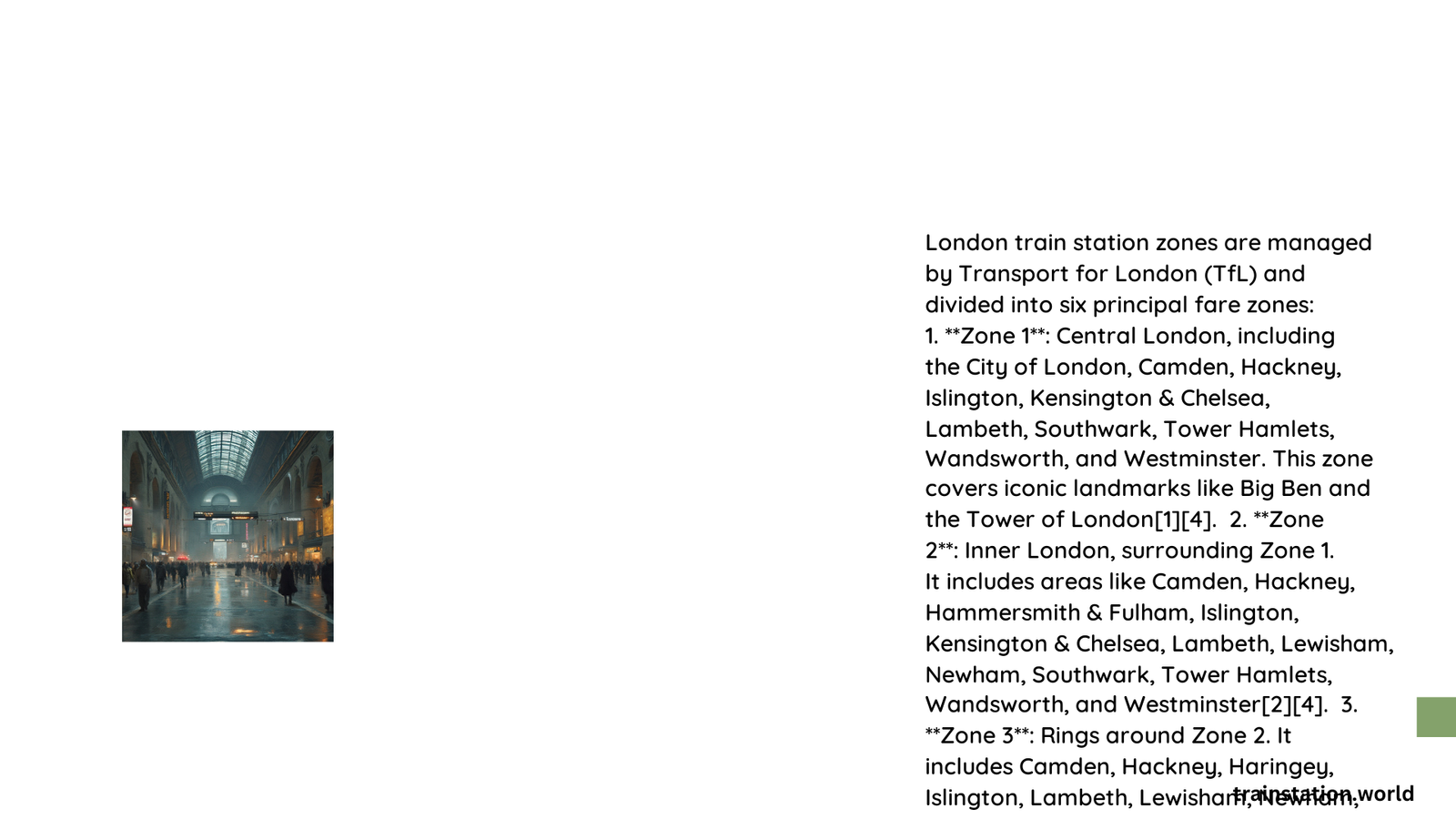London’s train station zones form a complex network of transportation hubs, divided into concentric circles radiating outward from the city center. This system, comprising nine zones, plays a crucial role in determining fares and organizing public transport across the Greater London area. Zone 1, the innermost circle, encompasses the heart of London and includes many of the city’s most iconic landmarks and busiest stations.
What are the London Train Station Zones?
London’s public transport network is divided into nine fare zones, with Zone 1 at the center and Zone 9 at the outermost periphery. These zones determine ticket prices and travel card validity. The system includes both underground (tube) and overground rail services, as well as some bus routes.
How is Zone 1 defined?
Zone 1 covers central London and includes the following boroughs:
- City of London
- Camden
- Hackney
- Islington
- Kensington & Chelsea
- Lambeth
- Southwark
- Tower Hamlets
- Wandsworth
- Westminster
This zone is roughly circular and contains many of London’s major attractions and busiest train stations.
What are the key stations in Zone 1?

Zone 1 houses several major transportation hubs, including:
- King’s Cross St. Pancras
- Oxford Circus
- Piccadilly Circus
- Victoria
- Waterloo
- London Bridge
- Euston
- Paddington
These stations serve as crucial interchange points for various underground lines and national rail services.
How do fares work within Zone 1?
Fares within Zone 1 are typically higher than in outer zones due to its central location and high demand. Here’s a breakdown of ticket options:
- Single Tickets:
- Peak hours: £7.20
-
Off-peak hours: £3.30
-
Day Travelcards (Zones 1-4):
- Peak hours: £13.10
-
Off-peak hours: £8.90
-
Weekly/Monthly Travelcards: Prices vary based on included zones
-
Contactless/Oyster Card: Daily cap of £7.20 for travel within Zone 1
Are there discounts for tourists?
Yes, several options are available for tourists:
- Visitor Oyster Card
- London Pass (can be combined with a Travelcard)
- Group discounts for 10 or more people
What amenities are available at major Zone 1 stations?
Major stations in Zone 1 offer a range of amenities:
| Amenity | Availability |
|---|---|
| Step-free access | Many stations, including King’s Cross St. Pancras, Victoria, and Waterloo |
| Lifts | Most major stations |
| Accessible toilets | Available at stations like Euston and Paddington |
| Parking | Limited, but available near some stations (e.g., Euston, King’s Cross) |
What notable activities or events are near Zone 1 stations?
Several Zone 1 stations are located near popular attractions:
- King’s Cross St. Pancras: Platform 9 ¾ (Harry Potter), British Library
- Victoria: Buckingham Palace, Victoria Palace Theatre
- Oxford Circus: Oxford Street and Regent Street shopping
- Waterloo: South Bank, National Theatre
How do the London Train Station Zones affect travel planning?
Understanding London’s train station zones is crucial for efficient travel planning:
- Cost considerations: Fares increase as you travel through more zones
- Time management: Knowing zone boundaries helps estimate travel times
- Travelcard selection: Choose the right zones for your itinerary
- Interchange planning: Identify key stations for changing between lines or services
What are the benefits of the zone system?
The London train station zone system offers several advantages:
- Simplified fare structure
- Encourages use of public transport
- Facilitates urban planning and development
- Helps manage congestion in central areas
How have the London Train Station Zones evolved over time?
The zone system has undergone several changes since its introduction:
- 1981: Original introduction of fare zones
- 1983: Extension to include British Rail services
- 1999: Introduction of Zone 6
- 2007: Addition of Zones 7-9
These changes reflect London’s growth and the expansion of its public transport network.
What future developments are planned for London Train Station Zones?
While no major changes to the zone structure are currently planned, ongoing improvements include:
- Expansion of step-free access at more stations
- Integration of new rail services (e.g., Elizabeth Line)
- Enhanced digital ticketing options
Understanding London train station zones is essential for navigating the city’s public transport system efficiently. Whether you’re a resident or a visitor, knowing how these zones work can help you plan your journeys, manage your travel costs, and make the most of your time in London.
References:
1. https://www.qmul.ac.uk/spcs/media/pprc/conferences/standard-tube-map.pdf
2. https://en.wikipedia.org/wiki/London_fare_zones
3. https://content.tfl.gov.uk/london-rail-and-tube-services-map.pdf
